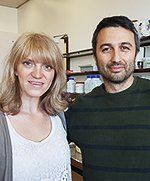Blog Layout
Life without insulin: Testing the anti-diabetic role of a candidate involved in inflammation

Hjelt grant holder 2017
Sanda Ljubicic och Giorgio Ramadori
University of Geneva
The liver appears to be sensitive to early decline of insulin production during the early stages of type 2-diabetes. By using cutting-edge techniques Cecilia Jiménez Sánchez, University of Geneva, will study the communication between liver cells and insulin producing beta cells in an attempt to find new biomarkers that predicts the development of the disease.
– It is not possible to assess functional beta cells due to its location in the pancreas, so an identification of sensitive and robust biomarkers in blood to identify early pre-diabetic stages is of major importance of diabetes prevention, she says.
The biological mechanisms that lead to type 2-diabetes often involve so called insulin resistance, which elevates the amount of insulin required to maintain normal blood glucose levels. The beta cells, located in islets in the pancreas, that produce insulin are able to temporarily adapt to this milieu by increasing their cell mass and insulin secretion, but eventually evolve to beta cell failure, promoting the diabetic state.
The liver appears to be sensitive to asymptomatic early decline of functional beta cell mass in a pre-diabetic stage. The associated key challenge raised by this observation is identification of the molecules signaling from the pancreatic islet when they start to lose their beta cells as a primary event, to the liver; and potentially the other way round.
– It could be that unidentified molecules released by the islets can trigger changes in metabolism of the liver, indicating there is an inter-organ crosstalk from islets to the liver, and vice versa during early diabetes stages, says Cecilia Jiménez Sánchez.
Cecilia Jiménez Sánchez will use a special mouse model which progressively develops dysfunction and death of beta cells that ultimately results in the spontaneous and gradual development of diabetes – and cutting-edge techniques such as transcriptomics and proteomics. This will enable studies of gene activity, how the genes affect other genes in the beta cells and the liver cells, and as proteins produced as a result of this activity.
– Identification of novel mechanisms and key molecules, will potentially open new routes of tissue signaling and provide novel insights into the progression of this metabolic disorder.
SPINA BIFIDA FOUNDATION
DIABETES FOUNDATION
ART FOUNDATION
© 2025
Hjelt Foundations | Webdesign by Delta
